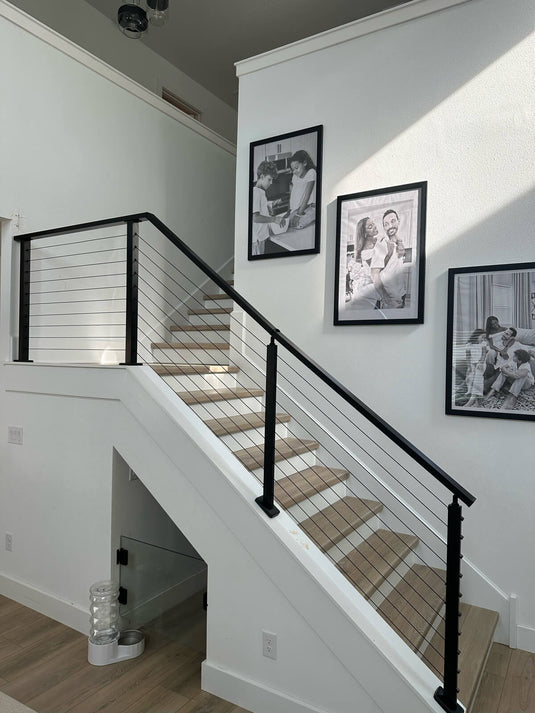TABLE OF CONTENTS
Choosing the Right Materials for Your Cable Railings for Deck: Durability vs. Aesthetics
A cable railing is a great choice for your deck, offering a clean look that preserves your view. But which materials should you choose? It’s a classic tug-of-war between stunning aesthetics and long-term durability. You need a railing that’s both beautiful and low-maintenance. This guide will walk you through your options, helping you confidently pick the right materials for a deck you’ll love for years to come.

Know the Lingo: What Are the Parts of a Cable Railing?
To make a good choice, it helps to know what you’re choosing between. A cable railing system is really just a few key parts. Getting these down will help you feel totally in control, whether you’re doing it yourself or hiring a pro.
- The Frame (Posts and Top Rail): This is the skeleton of your railing. The posts give it strength, and the top rail is what you’ll lean on. These parts make the biggest visual impact and define the overall style.
- The Infill (Cables): This is the see-through magic. The thin stainless steel cables are what give you that wide-open, modern feel.
- The Hardware: These are the small but mighty nuts, bolts, and fittings that connect the cables to the posts and pull them tight. Good hardware is key for safety and a polished look.

Let's Talk Frames: Comparing Your Main Options
The frame is your biggest style decision. Your choice here will set the tone for your whole deck and determine how much work you’ll have to do later on.
Stainless steel gives you that ultra-modern, sleek, almost commercial-grade look. It feels heavy-duty and looks incredibly sharp. It’s the strongest and most durable option out there, but that premium quality comes with a premium price tag. It's a real investment in longevity and style.
- Best for: Anyone going for that high-end modern look, homes near the coast (with the right grade of steel!), and people who want a "buy it once, have it for life" solution.
Aluminum is fantastic because it’s strong, lightweight, and won't rust. It’s usually powder-coated, which means you can get it in go-to colors like black, white, or bronze that can perfectly match your window trim or other home accents. Its lighter weight also makes it a bit friendlier for a DIY project.
- Best for: Pretty much any home or climate. It’s the perfect middle ground, offering a great look and excellent durability without the high cost of stainless steel.
You just can't beat the warm, inviting vibe of wood. Wooden posts and a matching top rail can feel traditional, rustic, and right at home on a classic wood deck. It's also generally the most budget-friendly option for the frame. But here’s the trade-off: that natural beauty needs protecting. You’ll be on the hook for regular staining or sealing to keep it from rotting, splitting, or graying out.
- Best for: Rustic or traditional homes, anyone wanting to perfectly match their wood deck, and those on a tighter budget who don't mind a little annual maintenance.
The One Detail You Can't Afford to Get Wrong: Steel Grade
Now for the most important insider tip. The cables themselves are always stainless steel, but not all stainless steel is the same. Picking the right grade is critical for how long your railing will look good.
This is the dependable industry standard. It’s strong and does a great job fighting off rust in most normal environments. If you live inland, away from the salty air, and in a climate that isn't excessively humid, Type 304 is a solid, cost-effective choice for your cables and fittings.
This is the tough-as-nails upgrade, and for some, it's not optional. Type 316 steel contains an extra ingredient that makes it far more resistant to corrosion from salt and harsh chemicals. If you live anywhere near the coast, have a saltwater pool, or are in a city with heavy pollution, this isn't a suggestion—it's a must-have. Spending a little extra on 316 is the best insurance you can buy for your investment.

Get Creative: How to Mix and Match Materials
You don’t have to stick to just one material! Some of the best-looking railings mix and match to create a custom style. This is your chance to get creative and design something that’s uniquely you.
Picture this: a Modern Farmhouse. You love the clean look of black railing, but want to warm it up. Use sleek black aluminum posts, but top them with a chunky wooden rail that matches your deck boards. It’s the perfect blend of modern and rustic.
Or how about an Industrial Touch? Maybe you have beautiful, substantial wood posts already built into your deck. You can add a cool, modern edge by installing a slim stainless steel top rail. It's a simple touch that makes a huge impact.
Quick Comparison: Which Material is Right for You?
Still weighing your options? This simple chart breaks it all down so you can easily compare based on what matters most to you.
| Material | The Vibe (Aesthetics) | Durability | Maintenance Level |
| Stainless Steel | Sleek, Modern, Industrial | Very High | Almost None |
| Aluminum | Clean, Versatile, Colorful | High | Almost None |
| Wood | Warm, Classic, Natural | Medium | High (Regular Sealing) |
A Note on Price: Prices vary a lot by region and manufacturer. As a very general rule, expect wood frames to be the most affordable, aluminum to be in the mid-range, and a full stainless steel system to be the most significant investment.
Make Your Final Call

The perfect railing is a personal choice, a balance of your style, budget, and local weather. There isn't one "best" material, just the one that’s right for your home. The key takeaway? Let your location be your guide, especially when choosing your stainless steel grade. Get that right, and you're not just building a railing—you're finishing an outdoor space where you’ll be making memories and enjoying the view for years.




